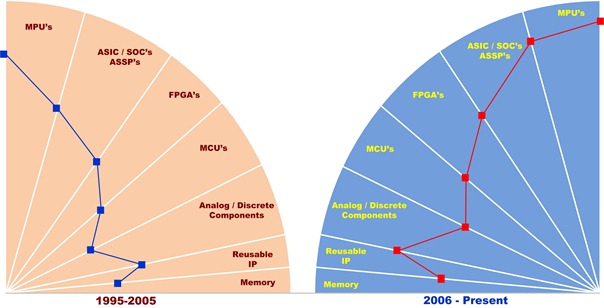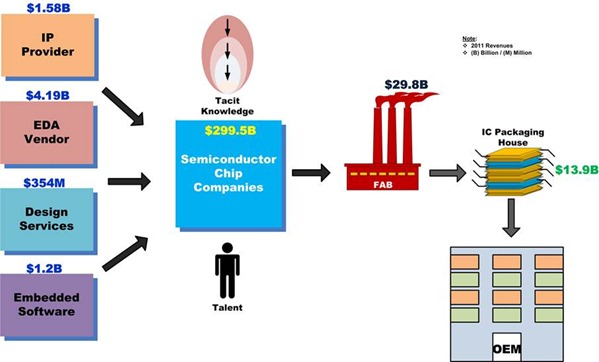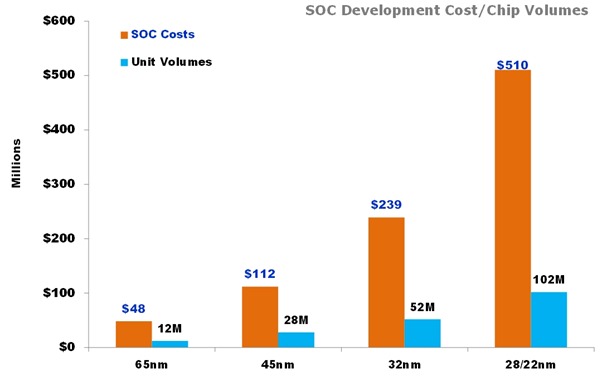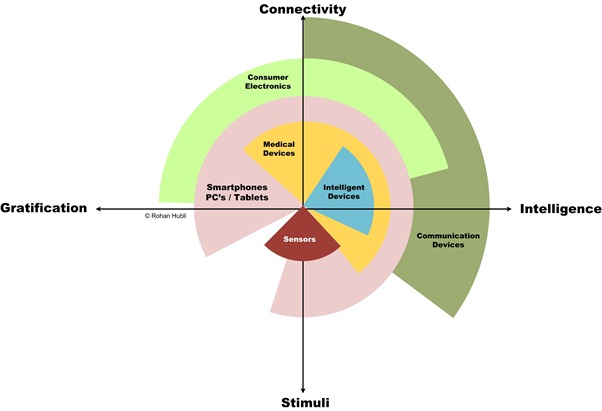Abstract: The Life Cycle theory on industry evolution suggests that the rate of knowledge obsolescence tends to diminish over time. In effect it deters new entrants from entering the industry; the ensuing shakeout forces industry consolidation and concentration. The fallout; operational efficiency, product proliferation and price discipline take center stage.
In the semiconductor industry the very presence of technological knowledge obsolescence has prevented industry shakeout and consolidation up until now. However, with escalating costs and the fundamental limits on device physics reaching a climax are the curtains descending on the semiconductor industry. If so, what are the ramifications for the industry and its ecosystem?
Downloads:
- Future of Semiconductor Business & Innovation
- Fabless Semiconductor Chip Startup Business Plan
- Semiconductor SOC Design Cost Model
First a brief look at the semiconductor industry dynamics:
| 1. Semiconductor fabrication plants exhibit exponential cost dynamics. Rock’s Law, named after the visionary venture capitalist Arthur Rock, predicts that the cost of a semiconductor fab will double every four years.
2. Semiconductor Industry is characterized as having very high fixed cost, and low variable costs. 3. A cutting edge semiconductor fab has an active life cycle that lasts anywhere between three and five years. The cyclical nature of the industry results in periods of high capital expenditure interspersed with bursts of revenue streams. 4. Moore’s Law, named after the visionary cofounder Gordon More of Intel, predicts that the size of a semiconductor chip will shrink by half every two years (everything else remaining the same). 5. Semiconductor chips although very design intensive benefit heavily from division of labor. 6. Semiconductor design exhibits compelling scope economies due to cumulative experience and design knowledge. 7. Semiconductor design is susceptible to significant knowledge obsolescence within domains. 8. Process and Product Innovation both happen at the same time. Firms either acting alone or together orchestrate process innovations that the entire industry draws upon. Product innovations on the other hand are firm specific. 9. The industry is highly competitive with low barriers to entry. However tacit knowledge and market reputation favor both scope and scale economies. |
Semiconductor Value Chain and State of the Industry
As of 2011, worldwide semiconductor sales attributed to IC’s and components reached $299.5 Billion. The market is fragmented across all sectors except in the area of microprocessors were a duopoly exists. The worldwide pure play semiconductor foundry market totaled $29.8 billion in 2011. The top five foundry players accounted for almost 80 percent of the foundry market share.
Electronic Design Automation (EDA) vendors accounted for revenues of $4.19 Billion in 2011. Semiconductor chip design, verification and implementation tools accounted for almost 90% of this market, with the rest owned by PCB design tools.
The market for semiconductor IP registered sales of $1.58 Billion. Design Services made up another $350 Million in revenue for 2011. IC Packaging and Assembly generated revenues of $13.9 Billion and the embedded software market registered sales of $1.2 Billion. Semiconductor FAB’s demonstrated revenues of $29.8 Billion in 2011.
Across the value chain semiconductor chip companies and semiconductor FABs account for the lion share of the revenue. The former exploits economies of scope and the latter economies of scale.
Revenue Drivers
Cost & Value Migration
An amalgamation of processor cores, feature rich IP and fab for hire have pushed the value frontier to a new normal. Aided by quantum jumps in feature size and design productivity, SOCs redefined products and markets.
The first generation of SOC’s saw processor, peripherals, interfaces and memory integrated. The second generation of SOC’s built on the previous by harnessing multiple cores, RF and power management functions. The third generation of SOC’s will bring together photonics, high density memory and MEMS into the main stream.
 Cost Performance Ratio, SOC’s – The New Normal
Cost Performance Ratio, SOC’s – The New Normal
On the value frontier, a leading edge System-on-Chip (SOC) offers cost-performance ratio that rivals the elite microprocessors of today. The new players with vastly different business models are increasingly threatening the old guard. However both have seen semiconductor design costs reach epic proportions.
With increasing levels of integration and multicore processors becoming the norm, hardware and software costs have exploded. Verification engineers and software developers now covet over half of the development team. As geometries shrink, tooling efforts to account for increasing variability of parameters and DFM (Design for Manufacturing) requirements have further exacerbated the problem.
The Economics of Chip Design
A typical semiconductor company spends anywhere from 20% to 25% of its revenue on R&D with COGS accounting for another 40%-45% and SG&A in the region of 10% – 15%. With these assumptions and using the Semiconductor Chip Design Cost Model the numbers that emerge tend to favor products that can be milked over relatively large periods of time or in markets with large demand side economics of scale.
To put things in perspective, the annual shipments of microprocessors (all segments) in 2011 stood at 350 Million units. High-end smartphone shipments reached 60 million units in 2011. The returns necessary to justify investment on a new chip requires double digit market share.
Fabless Semiconductor Startup:
The picture is no different for emerging startups wanting to unleash the next biggest idea or invention. Although startups rely on VC money to fuel R&D in the initial stages the return necessary to justify venture investment are increasingly out of reach for many.
A semiconductor startup pursuing an opportunity in a fast growing market needs to capture more than 10% market share and demonstrate higher probability of success. To deliver both, the odds are as good as winning the lottery. (See: Fabless Chip Startup Business Plan)
Startup Exit Valuation:
Note: Startup is funded, based and operates solely out of USA
Implications for Product Innovation
It is imperative for designers to leverage legacy designs, in die form, surround them with abundant memory and unleash rich software to create value. New alternatives in 2.5D packaging (side-by-side die on an interposer) or 3D packaging (Through-silicon-Vias) will aid this effort. Many low to medium volume applications will make this transition. OEM’s in commodity markets will increasingly adopt COTS and rely on ODMs/EMS to bring solutions. Software will be the basis for differentiation.
For high volume applications the next wave of innovation will require products that can integrate wider range of heterogeneous functions (mobility, sensing, intelligence, adaptability and connectivity).
The market will essentially evolve to provide one or all of the following functions- Intelligence, Connectivity, Stimuli and Gratification in varying degrees. A chip that can integrate all of the above functions and satisfy the needs (price/performance) of the market will unleash major realignment and shakeout within the industry.
| Imagine a TV in the not so distant future that morphs into a Gaming Console, a PC, a Web-TV or an entertainment hub based on the need. Embedded Hardware Virtualization will make this happen and enter mainstream market in a big way. |
Intelligent Devices constitutes another market area with a potential volume larger than PCs, Mobile Phones, Servers, and Tablets combined. With a 2020 vision of 25 Billion devices the market requires Sensing, LBS, Augmented Reality, Analytics, Security and Self-Monitoring to be prevalent in most nodes. A platform centric vision for intelligent nodes can unleash innovation and propel existing players to new heights.
We are entering a realm of devices capable of features analogous to what we humans are born with. Ironically most humans share the same feature set. It is the DNA that confers uniqueness and character. For chips, with similar features, software will emerge as the key differentiator and enabler that can morph into something unique depending on the context.
The Road Ahead
Globally the aging population (65+) will grow to 2 Billion by 2050. The world’s emerging middle class will reach 4.9 Billion by 2030. Developed and emerging economies share of the middle class will reverse from the current 50% to 22%. A slow-cycle market characterizes one and a fast-cycle market exemplifies the other. The challenge lies in managing both at the same time and within the same organization.
1. Industry Concentration: The minimum efficient scale (MES) for a semiconductor fab is nearing $10 Billion. For a fabless chip company the ratio of minimum sales volume (MSV) to market size has reached double digits (~15%). As platform products and services, with winner-take-all dynamics, become more prevalent, the industry will consolidate. Firms either need to pursue broad line differentiation or risk being caught in the middle where the future is anything but certain. Each market vertical will converge to the “Rule of Three” with an uptick in M&A based on horizontal product line reach.
2. New Business Models: The new winners will be those who can enrich customer captivity (combination of switching and search costs) and combine it with supply side economies of scope. The industry will favor fast-followers and late adopters over innovators. An asset lite model supplemented by just-in-time design methodology and standardized hardware platform with software differentiation will redefine competition.
3. Vertical Integration: OEM’s will be forced to ensure that their semiconductor suppliers remain viable and continue to create value. Some form of vertical integration either in the form of minority stake, multi-year supplier partnership or outright purchase will become a necessity. Pure play foundries and EDA specialists will integrate forward to offer one stop R&D solutions by assembling a portfolio of IP’s and engineering resources. At the technology level high density Memory (3D), MEMS, Interconnects, Photonics and Embedded Software are prime targets for M&A.
4. Operational Efficiency: Ultimately all firms needs to generate returns that cover the cost of capital. The less efficient companies will struggle merely to remain afloat. Efficiency governs all activities from engineering, production, marketing, sales, to operations. The organizational power structure, long the bastion of engineering, will cede control to marketing and finance. ROIC the new mantra.
5. R&D: Escalating costs, will force many chip companies to offshore R&D. In the next five years leading edge designs, the stronghold of Silicon Valley will move overseas as markets there become large. Many companies will transform their model to one of an IP provider. Foundries, the current gateway for all semiconductor chips will move up the value chain to offer one stop solutions as will EDA companies. Development of process technology for new nodes will require pooling of industry resources together.
6. Value Migration: For firms to generate economic profit it is imperative to adopt a software centric vision for the products as value migrates from hardware to software. Firms that can package and deliver hardware-software together will remain immune to commoditization and reap the benefits of lock-in and network effects. If you are somehow not plugged into one of the platforms, competition will force you out.
Closing Remarks:
As the economics of semiconductor business undergoes fundamental shift, changes in the value chain and ecosystem is inevitable. To sustain economic profits exploiting economies of scope in R&D resources will become critical and challenging. One business model that could disrupt the industry is “Just in Time Design” harnessing elements from Dell’s supply chain model and Toyota’s production management system. When transaction and search costs associated with semiconductor Intellectual Property and Engineering Talent intersect on an EBay like trading platform the vision will become a reality.
References:
- Semiconductor Annual Revenue Data sourced from WSTS, April 2012
- EDA Annual Revenue Data sourced from EDA Consortium MSS Newsletter, Q1-Q4 2011
- Semiconductor Foundry Market Data sourced from Gartner, March 2012
- Processor Market Shipments by Industry and Architecture, IDC, February 2012
- Semiconductor Industry Profitability Analysis based on financials from 2007 – 2011 of Top 10 players in each category excluding outliers. Data compiled from Annual reports, Morningstar, Bloomberg and SEC filings.
- 2011 PC Shipment Data, Gartner, January 2012
- 2011 High End Smartphone Shipment Data, Berg Insight, February 2012
- Intelligent Systems, The Next Big Opportunity, IDC, August 2011
- World Population Aging, United Nations
- World’s Emerging Middle Class, sourced from Dr. Homi Kharas, The Brookings Institution,
- Global Semiconductor Alliance, March 2012
- EDA Consortium, Quarterly Marketing Statistics (2011). Market Research Reports
- ChipSTAT Annual Review, April 2011
- NASSCOM, Opportunities in Embedded Software (2010)
Acknowledgments:
To my colleagues and peers in the semiconductor industry with whom I have shared and enjoyed an incredible journey. Your inputs on the Survey are highly appreciated. Thank You for taking the time to answer it.




